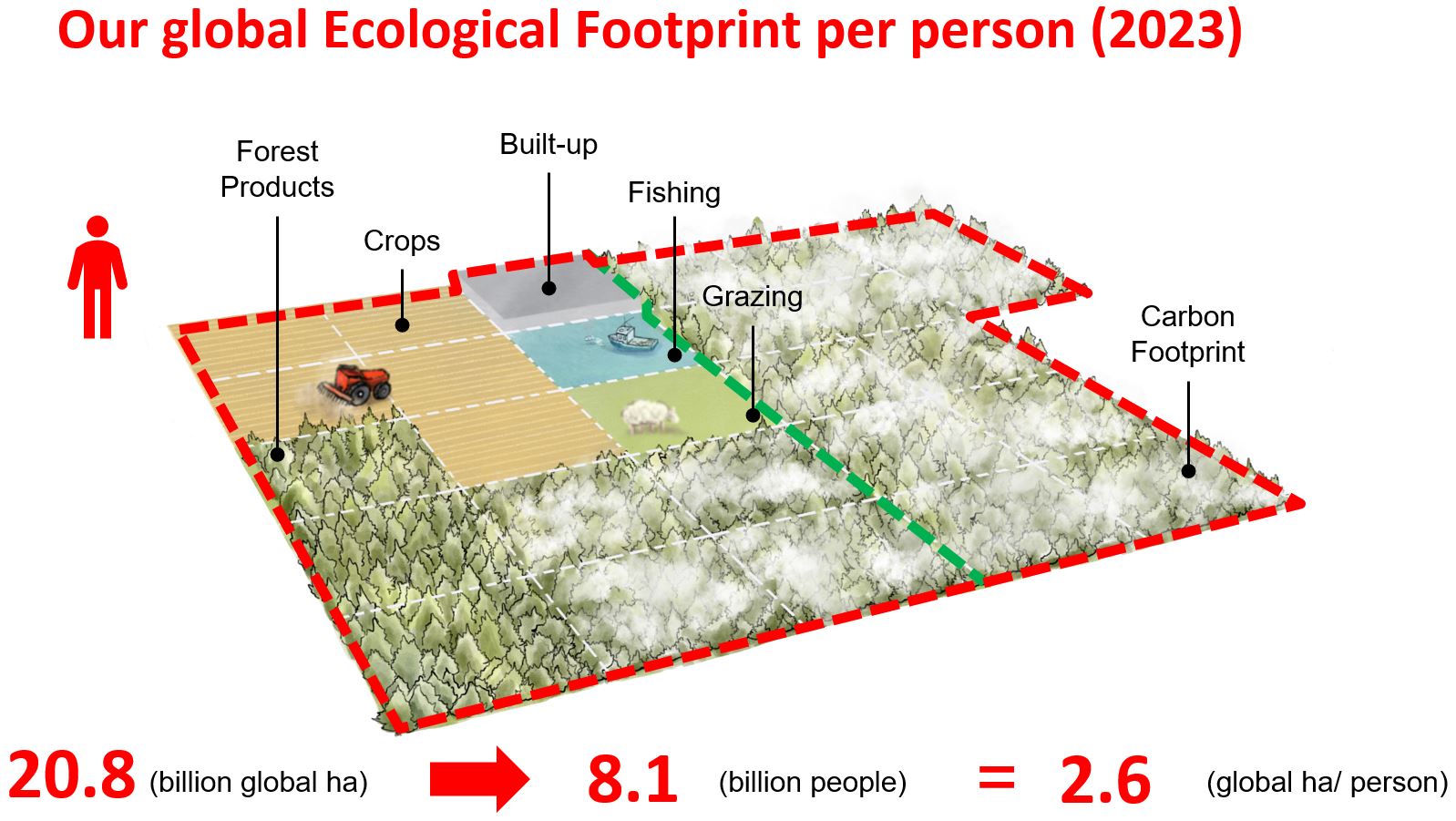What the Ecological Footprint measures
The Ecological Footprint is a metric of human demand on ecosystems, or more precisely on the planet’s biocapacity. It tracks how much mutually exclusive, biologically productive area is necessary to renew people’s demand for nature’s products and services. The principles and the measurement methods are described in detail in Borucke et al. (2013), Lin et al. (2018), Wackernagel et al. (2019), and in the supplement of Wackernagel et al. (2021). A fuller introduction is available in Wackernagel and Beyers (2019).
The demands on nature compete for biocapacity These demands compete for the biologically productive space that:
● provides food, fiber, timber, etc.
● accommodates roads and structures,
● enables energy production (from hydropower to biomass),
● absorbs or neutralizes economies’ waste, incl. CO2 from fossil fuel burning or cement production.

Humanity demands goods and services from nature that require 20.8 billion global hectares to renew them, as of 2023. This is more than the 12.2 billion global hectares of biologically productive area (or biocapacity) available on the planet. Excessive demand means that humanity, by now, uses 1.7 times more than the amount the biosphere currently renews. Some describe this level of consumption as using 1.7 Earths. For maintaining robust biodiversity and climate, ecologists estimate that humans should not demand more than half of the biocapacity on Earth, or over 3 times less than the current demand. (We gratefully acknowledge Foster+Partners for producing the initial version of this illustration).
Ecological Footprint accounts use as their measurement unit the “global hectare” which is a biologically productive hectare with world-average productivity. The carbon footprint is an integral part of the ecological footprint. In Ecological Footprint accounts, carbon emissions are expressed in global hectares, but often, carbon footprints are also measured in tonnes of CO2 per year. Also, many report only on the carbon footprint, and ignore its ecological context. In contrast, the water footprint, inspired by the ecological footprint, tracks embodied (virtual) water. Water use in the Ecological Footprint context is measured in terms of its embodied biocapacity.
While applicable at any scale, the most prominent accounts are the National Footprint and Biocapacity Accounts, based on UN statistics. They are now independently produced annually by the Footprint Data Foundation, in collaboration with York University, Toronto. Results for 2022 show that human demand exceeded the planet’s regeneration by at least 71% (York University et al. 2023).
For sub-global Ecological Footprint assessments, one needs to distinguish between:
- the consumption footprint – how much is embedded in final consumption, and
- the production footprint – how much is embedded in producing everything in the region, independent of where it is finally consumed.
Ignoring for simplicity’s sake annual stock changes, the difference between the two then is the footprint of net-imports.
The Ecological Footprint standards (https://www.footprintstandards.org), published in 2009, explain how Ecological Footprint accounting can be applied to all scales. You can find more on applying the Ecological Footprint for cities here, and for applications to companies here.
Ecological Footprint accounting, i.e., mapping overall demand against overall regeneration, is primarily used by those who recognize that regeneration is the materially most limiting factor for the human economy. Note that biological regeneration is also the most constraining physical factor for fossil fuel use, since the biosphere’s ability to cope with the CO2 emissions is even more limited than the reserves underground. The same holds true for mining ores and minerals, as they are plentiful in the Earth’s crust, but retrieving them also puts additional pressure on the biosphere. So, for those materials, it is also the ability of the biosphere to cope with these activities that is competing with other uses of the biosphere, and hence the limiting factor for the use of these underground resources.
For more details visit the introduction to the Ecological Footprint, or review the Frequently Asked Questions.
References
- Borucke, M. Moore, D. Cranston, G. Gracey, K. Iha, K. Larson, J. Lazarus, E. Morales, J. Wackernagel, M. and Gall A. 2013. Accounting for demand and supply of the Biosphere’s regenerative capacity: The National Footprint Accounts’ underlying methodology and framework. Ecological Indicators, Vol. 24, pp. 518–33. https://doi.org/10.1016/j.ecolind.2012.08.005
- Lin, David; Hanscom, Laurel; Murthy, Adeline; Galli, Alessandro; Evans, Mikel; Neill, Evan; Mancini, Maria S.; Martindill, Jon; Medouar, Fatime-Zahra; Huang, Shiyu; Wackernagel, Mathis. 2018. “Ecological Footprint Accounting for Countries: Updates and Results of the National Footprint Accounts, 2012–2018.” Resources, Vol 7, No. 3: 58. https://www.mdpi.com/2079-9276/7/3/58
- Wackernagel, Mathis and Bert Beyers, 2019. Ecological Footprint: Managing the Biocapacity Budget, New Society Publishers, Gabriola Island. https://www.footprintnetwork.org/2019/09/04/18187/
- Wackernagel, Mathis; Laurel Hanscom, Priyangi Jayasinghe, David Lin, Adeline Murthy, Evan Neill, Peter Raven. 2021. “The Importance of Resource Security for Poverty Eradication.” Nature Sustainability, Vol 4, pages 731–738. https://dx.doi.org/10.1038/s41893-021-00708-4
- Wackernagel, Mathis; Lin, David; Evans, Mikel; Hanscom, Laurel; Raven, Peter. 2019. “Defying the Footprint Oracle: Implications of Country Resource Trends.” Sustainability Vol 11, No. 7: 2164. https://www.mdpi.com/2071-1050/11/7/2164
- York University Ecological Footprint Initiative, FoDaFo & Global Footprint Network. National Footprint and Biocapacity Accounts, 2023 edition. Produced for FoDaFo (Footprint Data Foundation) and distributed by Global Footprint Network. Available online at: https://data.footprintnetwork.org.


